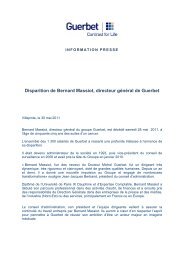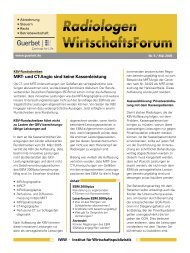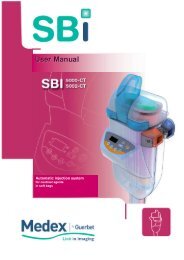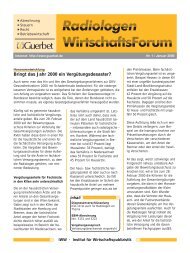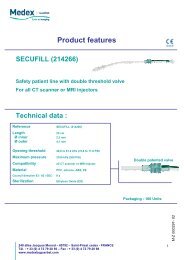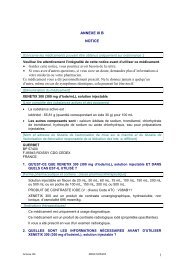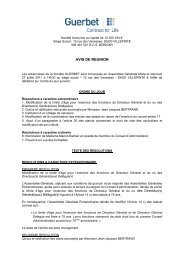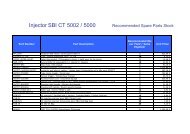Read the Registration Document - Guerbet
Read the Registration Document - Guerbet
Read the Registration Document - Guerbet
Create successful ePaper yourself
Turn your PDF publications into a flip-book with our unique Google optimized e-Paper software.
g) Research and development expendituresIn compliance with IAS 38, research costs are expensed in <strong>the</strong> period in which <strong>the</strong>y are incurred.According to IAS 38, development expenditures are capitalised as intangible assets only if <strong>the</strong> Group candemonstrate that <strong>the</strong>y meet <strong>the</strong> following criteria:- There exists an intent and financial and technical resources to complete <strong>the</strong> development;- It is probable that future economic benefits attributable to <strong>the</strong> asset will flow to <strong>the</strong> Group;- The cost of this asset can be measured reliably.Because of risks and uncertainties related to regulatory authorisations, <strong>the</strong> Group considers that expensesincurred in connection with obtaining market authorisations (AMM) do not meet <strong>the</strong> above definition ofintangible assets. Consequently, development expenditures are expensed in <strong>the</strong> period incurred.Fur<strong>the</strong>rmore, expenses incurred after market authorisations are obtained constitute selling costs that maynot be capitalised under IAS 38.h) Property, plant and equipmentProperty, plant and equipment are recorded at historical acquisition cost or production cost, Except for <strong>the</strong>Villepinte site recorded at fair value as of 1 January 2004 according to <strong>the</strong> option available under IFRS1 for<strong>the</strong> first time adoption of IFRS.All costs directly attributable and necessary for commissioning investments are capitalised, from pre-projectcosts (summaries and details) engineering costs to costs for validating and certifying installations.In accordance with revised IAS 23, borrowing costs are capitalised in <strong>the</strong> value of fixed assets for strategicinvestment projects spread over several months of manufacturing operations and having begun after 1January 2009.Equipment grants received are not deducted from <strong>the</strong> value of fixed assets but are presented according to<strong>the</strong>ir amortised value under deferred revenue.Depreciation allowances are calculated on a straight-line basis over <strong>the</strong> assets’ useful lives at acquisition orproduction cost. They are eventually restated, deducting when applicable <strong>the</strong>ir residual value. Depreciationis calculated on a straight-line basis over <strong>the</strong> estimated useful life of <strong>the</strong>se assets, i.e. on average:- Buildings: 20 to 50 years- Fixtures, fittings: 10 to 20 years- Machinery and equipment 5 to 10 years- O<strong>the</strong>r tangible assets: 5 to 10 yearsi) Impairment of fixed assetsGoodwill and indefinite life intangible assets are subject to an impairment test in accordance with IAS 36Impairment of assets, at least once a year or more frequently when <strong>the</strong>re exists evidence of impairment.The annual tests are carried out in <strong>the</strong> fourth quarter.O<strong>the</strong>r intangible assets are also subject to impairment tests whenever events or circumstances indicate that<strong>the</strong> carrying value of <strong>the</strong>se assets may not be recoverable.The impairment test involves comparing <strong>the</strong> carrying value of <strong>the</strong> asset with its recoverable value. Therecoverable amount of an asset is measured at <strong>the</strong> higher of its net selling price and value in use.Value in use is <strong>the</strong> present value of estimated future cash flows expected to arise from <strong>the</strong> continuing use ofan asset (or groups of assets) and its disposal at <strong>the</strong> end of its useful life. The discount rate applied is <strong>the</strong>pre-tax discount rate that reflects <strong>the</strong> current market assessments of <strong>the</strong> time value of money and <strong>the</strong> risksspecific to <strong>the</strong> asset. This corresponds to <strong>the</strong> expected rate of return investors would request if <strong>the</strong>y wererequired to choose an investment involving an amount, maturity and risk equivalent to <strong>the</strong> asset in question.The net selling price is <strong>the</strong> amount obtainable from <strong>the</strong> sale of an asset (or group of assets) betweenknowledgeable, willing parties in an arm's-length transaction after deducting any direct incremental disposalcosts.When impairment tests indicate a loss in value, an impairment is recorded so that <strong>the</strong> carrying amount doesnot exceed <strong>the</strong> recoverable value.77




